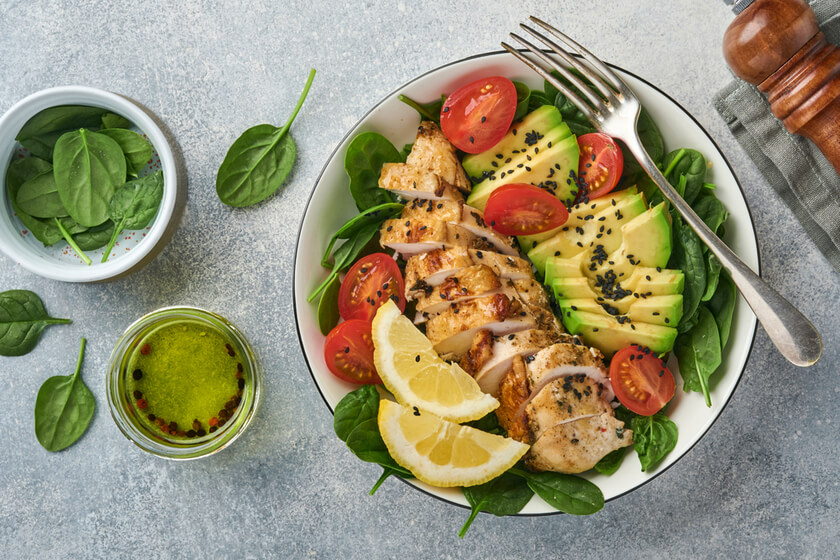Hungry While Fasting? Read This Ultimate Guide

You’ve heard celebrities, trainers, and bloggers sing praises about intermittent fasting (IF) for its ability to help you lose weight and improve your overall health. But many people still don’t understand what it actually entails. Is it a diet? A workout regime?
Intermittent fasting is an eating pattern where you eat within a specific window (usually 8 hours) each day and fast for the remaining hours (i.e., 16 hours). The idea behind IF is to give your body the chance to reboot and heal itself from the constant “stress” of digesting food every day.
However, just like with any other diet using an eating window, an intermittent fasting plan also presents hunger as an unavoidable side effect. While some people find this feeling of hunger completely unbearable, there is a way to cope with hunger pangs in an effective manner (with your busy schedule, no less).
To help you better understand the challenges this dietary pattern presents, in this article, we’ll explore the strategies to cope with the hunger hurdle. And armed with this information, you’ll be ready to take the IF plunge!
Hungry While Fasting: How to Deal With It?
If you feel hungry while fasting, you will be surprised to know that this feeling is quite common, and it can be overcome with the right mindset. When you feel that pang of hunger, distract yourself and your thoughts by drinking some water, sipping a cup of herbal tea, or simply stepping out for a jog or watching a movie instead.

Advertisement
Intermittent fasting can bring the body some tough moments in the initial few days. Hunger swings and energy changes are completely normal at this stage. Fortunately, there are several ways to override the hunger waves so your body can acclimatize to its new feeding pattern.
Avoid refined carbs
During an intermittent fasting regime, are you limited to eating high-carb dinners like pasta and bread? No! Remember that carbs are not your friend. They may taste great but provide little or no fiber, which is the key nutrition responsible for making you full for longer.
The result? The refined carbs only make you hungrier sooner, causing you to eat more until the feeling of hunger passes. Refined carbs also raise your blood sugar levels and can lead to the accumulation of extra fat around the stomach.
Are you really hungry?
Bored? Stressed? Anxious? Sad? Tired? Feeling any one of these emotions can trigger a hunger sensation. Sometimes, you hear yourself say, “I am hungry,” but your stomach isn’t growling, nor is your mouth watering. In this case, take deep breaths and ask yourself, “Am I hungry or am I simply trying to squash uncomfortable feelings?”

Aim for good sleep quality
Don’t you love snoozing? After hitting the hay, we have sweet dreams and wake up feeling charged. Unfortunately, if you are staying up late at night, you may be likely to crash in calories and make way for a bigger stomach. According to a recent study, people who got 4–6 hours of sleep nightly for two weeks experienced a 24% rise in ghrelin – the hormone that stimulates appetite and encourages you to hog in calorie-rich foods.
How Long Does Hunger Last?
The unpleasant feeling of hunger is commonly experienced as an effect of intermittent fasting. This hunger pang is not dangerous and will subside, but it’s tempting to wonder how long intermittent fasting hunger lasts.
It’s not uncommon for hunger pangs to last anywhere from 30 minutes to an hour. Most people find that the hunger passes after a few weeks of intermittent fasting, so it’s best not to be discouraged when it happens.
After evaluating 1,422 people who experienced their hunger subside with a fasting regimen lasting 4 to 21 days, it was found that the participants self-reported being less hungry after 3 days and no longer felt the need to snack by day 10. The NCBI study also states that their hunger subsides as their body acclimatized to a fasting regimen.
How to Feel Full While Fasting?
One of the effective ways to have a full appetite and manage hunger is to focus on conscious eating. It is the act of choosing foods that make you feel full and satisfied instead of tired and sluggish. The struggle may be real as you desperately want to go back to your old ways – cookie cake and ice cream!
But you can help yourself by eating healthy alternatives that don’t make your body produce a lot of insulin like white carbs do. These include white rice, pasta, potatoes, and white bagels, to name a few. The answer to feeling full longer is whole-grain pasta, 100% whole-wheat bread, brown rice, and oats.

Your Personal Intermittent Fasting App
- Progress tracker and calendar
- Calorie tracker
- More than 5,000 healthy recipes
- Training routines
- Daily motivation and tips
- Water intake targeting
- Daily caloric intake tracker
Intermittent Fasting and Hunger: 6 Effective Tips How to Beat It
This segment provides you with a sound and groovy solution for overcoming hunger pangs and cravings during your intermittent fast.
#1 Drink water
We all know that drinking water is vital to keeping the body strong and healthy. But did you know that drinking water during intermittent fasting can be an incredibly effective tool? That’s right! Unlike caloric beverages, which could lead to fat gain, water will help your body feel more satiated and reduce hunger cravings and carb cravings so that you’re less likely to overeat.
#2 Eat more protein-rich foods
Protein is digested slower than carbohydrates and fat, keeping blood sugar and insulin levels low. This helps you feel fuller for longer and provides the body with leptin, a hormone that helps you feel satiated. Ensuring you don’t binge or snack between fasting windows.

#3 Start with a mild eating pattern
As with any major change, it’s important to give yourself time to adjust your eating pattern and manage settings. You can always start slow, like practicing a 12:12 fasting approach. This means following a normal 12-hour schedule that allows eating during daylight hours! And then extending your fast overnight to adapt to the intermittent fasting window.
#4 Avoid alcohol
Did you know that alcohol changes the levels of blood sugar? Also, the carbohydrates in alcoholic drinks increase the level of the hunger hormone ghrelin in your body that stimulates hunger even when you’re not feeling hungry. In fact, hunger hormones can spike up to 5 hours after you’ve consumed alcohol.
#5 Don’t forget healthy fats
Healthy fat is the missing link between intermittent fasting and sustainable long-term weight loss. Fats are the most satiating macronutrient, which means they’ll keep you feeling full longer. A little healthy fat goes a long way, so choose to eat high-quality fats like avocado, coconut oil, and ghee for sustained energy and focus.

#6 Choose the right fasting plan for your lifestyle
If you’re new to intermittent fasting, it may seem complex and confusing at first. There’s no one perfect method of intermittent fasting, but your success is dependent on the strategy you use. As with any healthy eating plan, it’s important to experiment and find what works best for you.
The 16/8 method is a fasting plan that requires you to fast for 16 hours and only eat within an 8-hour period. For instance, you eat from 12 PM to 8 PM and fast for the rest of the day.
The 5:2 dietary pattern is a form of intermittent fasting that involves eating what you typically eat 5 days of the week and restricting your calorie intake to 500 (women)–600 (men) for the remaining 2 days.
The Warrior Diet is based on the idea of eating big in the evening and fasting throughout most of the day. Although there are no specific foods that are required for this diet, it does recommend that most of your calories come from high-quality proteins.
With a gamut of options, it can be an uphill task to pick the most compatible form of intermittent fasting. This is when you can take the colossal help of the DoFasting app, which is your all-in-one resource for the daily fast.
It’s a mobile app designed to help you reap the benefits of intermittent fasting without having to worry about tracking your meal times and preparations. In fact, you can sign up for a 7-day, 14-day, 21-day, or full-month fasting (28 days) challenge. It comes with a detailed description of what you can expect during this time and how to achieve optimal results.
Through individually tailored fasting programs, the DoFasting app helps you build healthy fasting habits, offers customized meal plans, and provides easy workouts compatible with your fasting schedule.
A Word From RD
Incorporating healthy fat keeps you feeling full longer and is important for your body to stay at a healthy weight. It is simple, just add 2 to 3tbsp of healthy fat to your evening meal. You can add olive oil, coconut butter, or even avocado to the last meal of the day.
The healthy fats help you absorb nutrients from other foods, provide energy, and keep your blood sugar levels steady throughout the night while also keeping you feeling full.
Also, using these fats can help keep that afternoon slump and hunger pangs at bay.
Final Word
There are different intermittent fasting protocols, and some people do much better on certain protocols than others.
As with anything, if you feel good when fasting and can sustain it as a lifestyle, then it can be a very powerful tool to lose weight and gain health benefits.
To know how significant a difference intermittent fasting makes to your lifestyle, give my story about intermittent fasting a read.







Comments (0)